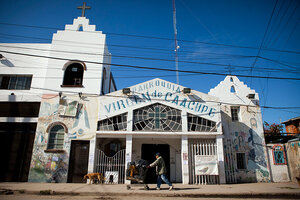In Kirchner's 'winning decade' Argentina's poor may lose
The slums of Buenos Aires, called villas miserias, grew by 50 percent from 2001 to 2010. The government also has not released any poverty data this year, causing critics to pounce.

A man pushes a cart past the Virgin of Caacupe church in the Villa 21-24 slum in Buenos Aires, Argentina, March 14, 2013. The slums of Buenos Aires, called villas miserias, or towns of misery, grew by 50 percent from 2001 to 2010, according to the municipal government.
Victor R. Caivano/AP/File
Buenos Aires
From a rooftop in the heart of the Villa 21-24 slum, it’s impossible to see the polluted river just a couple hundred yards away. The view is obstructed by a precarious jungle of orange cinder-block buildings, in some places reaching four stories high. Down below, the lives of some of Argentina’s poorest people play out on hardpan soccer fields and in crooked alleyways that cleave entire blocks.
The slums of Buenos Aires, called villas miserias, or towns of misery, grew by 50 percent from 2001 to 2010, according to the municipal government. Their sprawl on the ground is restricted in this crammed city, so they have started expanding upward.
The image of slums swelling across Argentina is a problematic one for Kirchnerismo, President Cristina Fernández de Kirchner’s political model that is centered on social equality. Similar to other leftist administrations in the region, her government has made wealth distribution through social benefits for the poor a cornerstone of her six years in office.
Despite a challenging economic climate – including slowing growth and rampant inflation, compounded by a devaluation of the peso in January – President Kirchner has trumpeted her government’s focus on the poor. And with voters and the media turning their attention to presidential elections next year, analysts say Kirchner, who is constitutionally barred from running for a third consecutive term, is looking to solidify her legacy. She wants it to be remembered as the “winning decade.”
'Sweeping evidence under the rug?'
For some observers, the growth of the slums is linked to recent immigration waves. For others, it's a sign that Kirchner's policies haven’t panned out. That view gained traction recently when the government failed to publish the official poverty rate, a figure that has been hotly contested in the past.
“What they say does not coincide with what they do,” says Jorge Lanata, a prominent broadcast journalist who is among Kirchner’s fiercest critics. “Governments are measured by what they leave behind.”
The government’s failure to publish poverty figures is akin to “sweeping the evidence under the rug,” opposition politician Martín Lousteau said in a recent newspaper column about inflation and poverty.
The poverty rate at the end of 2013 was around 26 percent, more than 10 million people, according to one university. An organization aligned with the government calculated a much lower rate of 18 percent. But both numbers are significantly higher than the most recent official figures, published over a year ago.
Government statistics for the beginning of 2013, the latest available, show the poverty rate was just five percent, an extreme decline from 48 percent in May 2003, when Kirchnerismo began. Since then, there have been 11 years of consecutive rule by Kirchner and her predecessor and late husband, Néstor Kirchner. He came to power in the wake of a severe economic crisis.
A stretch
Jorge Capitanich, the cabinet chief, said the government did not publish the latest figures because it is updating its methodology. Inflation has been underreported for years, and the government recently came out with a new official index to measure it. Critics say the government feared measuring poverty against the new index because it would have pushed the poverty rate far above five percent.
“Publishing the rate would have had a high political cost,” says Tamara Seiffer, a social scientist here who specializes in poverty.
Inflation means salaries here are covering fewer basic family costs. In the first quarter of this year alone, prices shot up by nearly 12 percent, according to the new official index.
“My wage doesn’t stretch for what I need,” says Miguel Ángel Olazar, a builder who lives in Villa 21-24, on the south side of Buenos Aires. “The price of food goes up every week.” He accused the government of lying about the extent to which it has reduced poverty.
As real wages fall, workers feeling the pinch have staged nationwide strikes. In an effort to buffer Argentina’s poor against the inflationary spiral, in June the government will increase by 40 percent its flagship child benefit program, claimed by nearly two million families. The monthly payment will increase from $57 to $80.
A 'paradox'
Social and education benefits, including the child benefit and a new subsidy for college students, formal job creation, and transportation and energy subsidies have been at the heart of the government’s plan to create a more equal society. The government spends nearly $7 billion a year on family assistance, Kirchner said in a recent speech.
But the growth of the slums presents a “paradox,” says Raúl Fernández Wagner, a professor of urban planning here who specializes in housing. From 2001 to 2012, economic growth in Argentina was accompanied by rising urban land values. Prices tripled in Buenos Aires, according to the municipal government. And despite a government program that provides poor families with loans for building or buying legal homes, many remain “prisoners” to the slums, Mr. Fernández Wagner says.
“How am I ever going to get out of here?” says Miguel Leiva, a bus driver from Villa 21-24. “I can’t afford it.”

